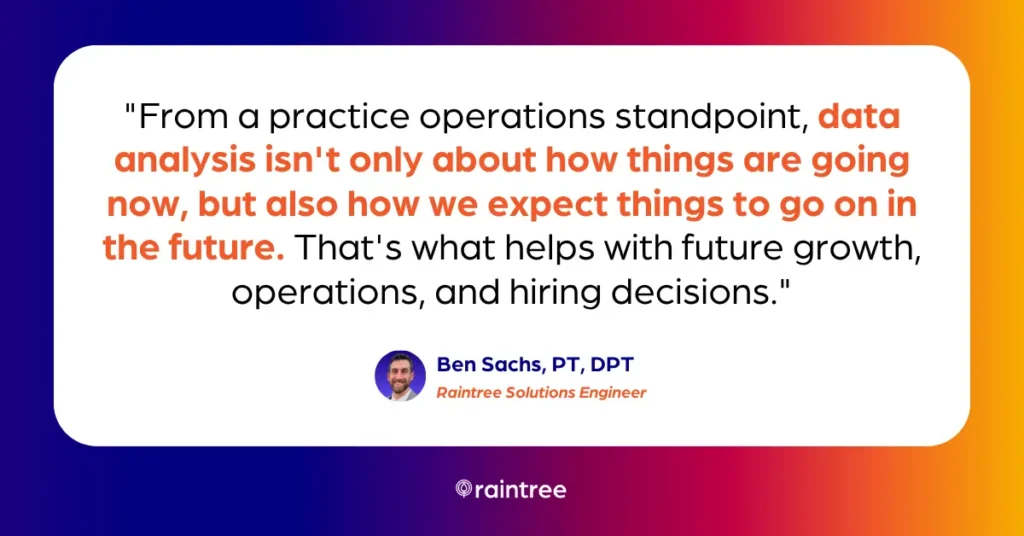In many physical therapy and rehab organizations, data is scattered across platforms, departments, and spreadsheets. But when leadership can’t see the full picture, it costs you opportunities to grow the business or catch issues before they escalate.
According to a literature review published in Health Affairs, administrative complexity is the largest source of waste in U.S. healthcare, contributing to up to $265 billion in preventable annual spending.
The good news is that, by bringing operational efficiency, financial, and outcomes data together, business intelligence (BI) tools boost PT practice growth potential by giving your teams a clear path forward.
Using PT Clinic Data to Grow Your Practice
In outpatient PT, misalignment in front office, clinical, or back office operations often lead to a downstream impact the patient experience and your long-term success. But when practice data is unified and presented as actionable insights, leaders gain the clarity they need to make informed decisions and drive business growth.
What Is Business Intelligence Software in PT?
Business Intelligence (BI) software collects, organizes, and visualizes key data from across your systems—EMRs, billing platforms, scheduling tools, budgeting software—into a central dashboard.
In rehabilitation and physical therapy, a strong BI platform:
- Tracks patient outcomes over time
- Measures provider productivity
- Monitors RCM performance (including denials, lag days, and net collection rates)
- Benchmarks financial and clinical metrics across locations or providers
- Forecasts revenue based on historical production
Instead of relying on manual reporting and spreadsheets, leadership can get real-time answers to key questions like:
- How are we performing compared to budget?
- Which clinics or therapists are under- or over-performing?
- Where are we losing revenue opportunities—and why?
The Shift from Hindsight to Foresight
Many PT organizations rely on monthly or quarterly performance snapshots that may already be outdated by the time they’re compiled. BI replaces that lag with live dashboards and automated alerts that signal problems as they develop.
During a recent webinar, “Insight to Impact: Making Data Work for Your Rehab Therapy Organization,” Ben Sachs, PT, DPT emphasized the shift from hindsight to foresight:
“ The BI tool helps businesses move from reactive decision making to a more proactive decision approach … [leading to] better outcomes for our patients and financial stability of our practices, by transforming data into more actionable intelligence.”

This forward-looking insight is essential for PT practice growth, especially in competitive markets where agility is critical. Examples include:
- Monitoring schedule utilization capacity
- Tracking predicted, billed, and collected revenue
- Benchmarking patient reported outcomes against industry standards
- Identifying slow-paying payers based on real-time payment lag tracking
Unified Data Drives Alignment and Scale
Centralized reporting and analytics doesn’t just give top-down visibility, it also helps to align teams across your organization. With automated dashboards and scheduled reporting, clinic managers, directors, executives, and practice owners can all work from the same trusted, up-to-date data.
That alignment means:
- Faster decisions at the local level
- Better communication across departments
- Stronger accountability on shared KPIs
- And scalable operations built on real-time insight, not guesswork
As Indhu Lakshman, Director of Product Management at Raintree, put it: “When data like patient, financial, and operational metrics live in separate silos, it becomes difficult to understand overall practice performance. Wouldn’t it be nice to have it in one system?”
How Olympic Sports & Spine Uses Business Intelligence
Olympic Sports & Spine (OSS)—a 20-clinic practice offering outpatient adult rehabilitation in Washington state—exemplifies how integrated data can support smarter, more scalable physical therapy practice operations.
Tim Pierson, VP of Clinical Operations and IT at OSS, shared how BI helped unify insights across departments: “ It’s a quick and easy way to slice and dice or drill down into various components of the data, being able to compare clinics, data over time, or even [look at] specific providers, cases, or referral sources.”
For example, OSS uses business intelligence analytics to support their athletic training program, which operates across 27 high schools. Previously, data on injuries, referrals, and training room visits was tracked manually and separately, layering on administrative tasks and costing precious time.
Now, using business intelligence dashboards, OSS tracks trends in school-specific injuries, seasonal spikes, and athlete referrals, insights that directly influence staffing, marketing outreach, and even contract negotiations with districts. This initiative made it possible to measure return on investment (ROI), helping OSS tie community engagement efforts directly back to patient needs and clinic-level growth.
Why Using EHR Data Is Key to PT Practice Growth
Whether you operate five clinics or fifty, growing your physical therapy practice depends on clarity: knowing where you’re excelling, where you’re falling short, and where to invest next.
Using data to drive growth strategies helps rehab organizations:
- Monitor financial health and revenue trends in real-time
- Improve clinic-level accountability with automated, role-specific dashboards
- Identify underperforming service lines, providers, or locations
- Track and improve patient outcomes with benchmarking capabilities
- Build data-backed strategies for payer negotiations and expansion
Pierson summed it up by saying: “The thing you shouldn’t do with data, in my opinion, is to just make assumptions to validate what you already think. Let the data provide the answers, and then you can make actionable steps to address it.”
Better Decision-making for Sustainable Growth
In a competitive, margin-sensitive industry, PT business growth doesn’t come from working harder. It comes from making smarter decisions. If your team is still working from spreadsheets, siloed systems, or monthly guesswork, now is the time to bring your data together.
Centralizing your clinical, financial, and operational data with business intelligence tools doesn’t just streamline reporting unlocks a smarter, faster, and more scalable way to grow and run your practice.
Explore Raintree Business Intelligence by watching the “Insight to Impact: Making Data Work for Your Rehab Therapy Organization” webinar on demand. Ready to dive deeper? Schedule a demo.

